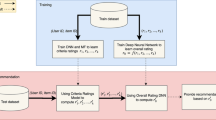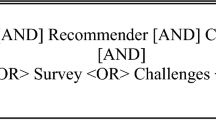Abstract
In recent years, the ever-growing contents (movies, clothes, books, etc.) accessible and buyable via the Internet have led to the information overload issue and therefore the item targeting problem. Indeed, the huge mass of contents complexifies the identification of items fitting users’ expectations. As powerful filtering tools, recommender systems efficiently alleviate the item targeting issue. Collaborative filtering-based methods are among the most influential algorithms adopted in recommender systems. Among collaborative filtering-based methods, model-based approaches are widely used in recent powerful recommendation methods. Due to its efficiency, the matrix factorization technique is spreadly employed in model-based approaches. However, those methods badly deal with issues such as data sparseness and cold-start problems that severely affect the recommendation quality. To overcome these limitations shown by state-of-the-art methods, we propose in this paper a recommender approach that couples the effectiveness of an enhanced matrix factorization technique to the power of a deep neural network model. In the first step, the user’s latent factors and item latent factors are extracted from a doubly-regularized matrix factorization process. Thereafter, those latent factors are used to feed a deep learning structure in a forward-propagation process, and a normalized cross-entropy method is used to increase the precision of the deep neural network through a backpropagation process. The end prediction is made by combining results from the matrix factorization step and the deep neural structure. Extensive experiments are conducted on real-world datasets and show that our proposal outperforms other methods in terms of prediction accuracy and recommendation quality.











Similar content being viewed by others
References
Ahamed MT, Afroge S (2019) A recommender system based on deep neural network and matrix factorization for collaborative filtering. pp 1–5
Ahmadian S, Meghdadi M, Afsharchi M (2018a) Incorporating reliable virtual ratings into social recommendation systems. Appl Intell 48(11):4448–4469
Ahmadian S, Meghdadi M, Afsharchi M (2018b) A social recommendation method based on an adaptive neighbor selection mechanism. Inf Process Manag 54(4):707–725
Ahmadian S, Afsharchi M, Meghdadi M (2019) A novel approach based on multi-view reliability measures to alleviate data sparsity in recommender systems. Multimed Tools Appl 78(13):17763–17798
Birtolo C, Ronca D (2013) Advances in clustering collaborative filtering by means of fuzzy c-means and trust. Expert Syst Appl 40(17):6997–7009
Da’u A, Salim N (2019) Sentiment-aware deep recommender system with neural attention networks. IEEE Access 7:45472–45484
Du R, Lu J, Cai H (2019) Double regularization matrix factorization recommendation algorithm. IEEE Access 7:139668–139677
Galushkin AI (2007) Neural Network Theory. Springer-Verlag, Berlin, Heidelberg
Goldberg Y (2016) A primer on neural network models for natural language processing. J Artif Intell Res 57:345–420
Guo G, Zhang J, Yorke-Smith N (2016) A novel recommendation model regularized with user trust and item ratings. IEEE Trans Knowledg Data Eng 28(7):1607–1620
He X, Liao L, Zhang H, Nie L, Hu X, Chua TS (2017) Neural collaborative filtering. In: Proceedings of the 26th International conference on world wide web, international world wide web conferences steering committee, Republic and Canton of Geneva, CHE, WWW ’17, p 173-182, 10.1145/3038912.3052569
He X, He Z, Song J, Liu Z, Jiang YG, Chua TS (2018) Nais: Neural attentive item similarity model for recommendation. IEEE Trans Knowl Data Eng 30(12):2354–2366
Hernando A, Bobadilla J, Ortega F (2016) A non negative matrix factorization for collaborative filtering recommender systems based on a Bayesian probabilistic model. Knowl-Based Syst 97:188–202
Hong R, Hu Z, Liu L, Wang M, Yan S, Tian Q (2015) Understanding blooming human groups in social networks. IEEE Trans Multimed 17(11):1980–1988
Huang Z, Yu C, Ni J, Liu H, Zeng C, Tang Y (2019) An efficient hybrid recommendation model with deep neural networks. IEEE Access 7:137900–137912
Jayapriya K, Mary NAB, Rajesh RS (2016) Cloud service recommendation based on a correlated QoS ranking prediction. J Netw Syst Manag 24(4):916–943
Jiao J, Zhang X, Li F, Wang Y (2019) A novel learning rate function and its application on the svd++ recommendation algorithm. IEEE Access 8:14112–14122
Li K, Zhou X, Lin F, Zeng W, Alterovitz G (2019) Deep probabilistic matrix factorization framework for online collaborative filtering. IEEE Access 7:56117–56128. https://doi.org/10.1109/ACCESS.2019.2900698
Kapetanakis S, Polatidis N, Alshammari G, Petridis M (2019) A novel recommendation method based on general matrix factorization and artificial neural networks. Neural Comp Appl 32(16):12327–34
Kluver D, Ekstrand MD, Konstan JA (2018) Rating-based collaborative filtering: algorithms and evaluation. Social Inf Access. https://doi.org/10.1007/978-3-319-90092-6_10
Ko YJ, Maystre L, Grossglauser M (2016) Collaborative recurrent neural networks for dynamic recommender systems. In: Journal of Machine Learning Research: Workshop and conference proceedings 63
Lara-Cabrera R, González-Prieto Á, Ortega F, Bobadilla J (2020) Evolving matrix-factorization-based collaborative filtering using genetic programming. Appl Sci 10(2):675
Li G, Zhu T, Hua J, Yuan T, Niu Z, Li T, Zhang H (2019a) Asking images: Hybrid recommendation system for tourist spots by hierarchical sampling statistics and multimodal visual bayesian personalized ranking. IEEE Access 7:126539–126560
Li W, Zhou X, Shimizu S, Xin M, Jiang J, Gao H, Jin Q (2019b) Personalization recommendation algorithm based on trust correlation degree and matrix factorization. IEEE Access 7:45451–45459
Lian D, Xie X, Chen E (2019) Discrete matrix factorization and extension for fast item recommendation. IEEE Transa Knowl Data Eng
Liang T, Zheng L, Chen L, Wan Y, Philip SY, Wu J (2020) Multi-view factorization machines for mobile app recommendation based on hierarchical attention. Knowl-Based Syst 187:104821
Liu X, Xie L, Wang Y, Zou J, Xiong J, Ying Z, Vasilakos AV (2020) Privacy and security issues in deep learning: a survey. IEEE Access 9:4566–4593
Luo X, Zhou M, Xia Y, Zhu Q (2014) An efficient non-negative matrix-factorization-based approach to collaborative filtering for recommender systems. IEEE Trans Industr Inf 10(2):1273–1284
Luo X, Zhou M, Li S, You Z, Xia Y, Zhu Q (2015) A nonnegative latent factor model for large-scale sparse matrices in recommender systems via alternating direction method. IEEE Trans Neural Netw Learn Syst 27(3):579–592
Ma X, Guo D, Cui L, Li X, Jiang X, Chen X (2019) Som clustering collaborative filtering algorithm based on singular value decomposition. pp 61–65
Massa P, Avesani P (2005) Controversial Users Demand Local Trust Metrics: An Experimental Study on Epinions.Com Community. In: Proceedings of the 20th national conference on artificial intelligence - Volume 1, AAAI Press, AAAI’05, pp 121–126, http://dl.acm.org/citation.cfm?id=1619332.1619354, event-place: Pittsburgh, Pennsylvania
Ortega F, Hernando A, Bobadilla J, Kang JH (2016) Recommending items to group of users using Matrix Factorization based Collaborative Filtering. Inf Sci 345:313–324
Valdiviezo-Diaz P, Ortega F, Cobos E, Lara-Cabrera R (2019) A collaborative filtering approach based on Naïve Bayes Classifier. IEEE Access 7:108581–108592. https://doi.org/10.1109/ACCESS.2019.2933048
Parvin H, Moradi P, Esmaeili S, Qader NN (2019a) A scalable and robust trust-based nonnegative matrix factorization recommender using the alternating direction method. Knowl-Based Syst 166:92–107
Parvin H, Moradi P, Esmaeili S, Qader NN (2019) A scalable and robust trust-based nonnegative matrix factorization recommender using the alternating direction method. Knowl-Based Syst 166:92–107
Du R, Lu J, Cai H (2019) Double regularization matrix factorization recommendation algorithm. IEEE Access 7:139668–139677. https://doi.org/10.1109/ACCESS.2019.2943600
Ramachandran P, Zoph B, Le QV (2017) Swish: a self-gated activation function. arXiv preprint arXiv:171005941:7
Rastegari M, Ordonez V, Redmon J, Farhadi A (2016) Xnor-net: Imagenet classification using binary convolutional neural networks. pp 525–542
Sakar CO, Polat SO, Katircioglu M, Kastro Y (2019) Real-time prediction of online shoppers’ purchasing intention using multilayer perceptron and lstm recurrent neural networks. Neural Comput Appl 31(10):6893–6908
Salakhutdinov R, Mnih A (2007) Probabilistic matrix factorization, NIPS’07. Curran Associates Red Hook, NY, USA, pp 1257–1264
Shoja BM, Tabrizi N (2019) Customer reviews analysis with deep neural networks for e-commerce recommender systems. IEEE Access 7:119121–119130
Su X, Khoshgoftaar TM (2009) A survey of collaborative filtering techniques
Tripathi GC, Rawat M, Rawat K (2019) Swish activation based deep neural network predistorter for rf-pa. pp 1239–1242
Wang H, Wang N, Yeung DY (2015) Collaborative deep learning for recommender systems. In: Proceedings of the 21th ACM SIGKDD international conference on knowledge discovery and data mining, association for computing machinery, New York, NY, USA, KDD ’15, p 1235-1244, 10.1145/2783258.2783273
Wang Q, Peng B, Shi X, Shang T, Shang M (2019) Dccr: Deep collaborative conjunctive recommender for rating prediction. IEEE Access 7:60186–60198
Wen S, Wang C, Li H, Zheng G et al (2019) Parallel naïve bayes regression model-based collaborative filtering recommendation algorithm and its realisation on hadoop for big data. Int J Inf Technol Manage 18(2/3):129–142
Xue HJ, Dai X, Zhang J, Huang S, Chen J (2017) Deep matrix factorization models for recommender systems. In: IJCAI, pp 3203–3209
Zhang Y, Meng K, Kong W, Dong ZY, Qian F (2019) Bayesian hybrid collaborative filtering-based residential electricity plan recommender system. IEEE Trans Industr Inf 15(8):4731–4741. https://doi.org/10.1109/TII.2019.2917318
Yang S, Hao K, Ding Y, Liu J (2018) Vehicle driving direction control based on compressed network. Int J Pattern Recognit Artif Intell 32(08):1850025
Yi B, Shen X, Liu H, Zhang Z, Zhang W, Liu S, Xiong N (2019) Deep matrix factorization with implicit feedback embedding for recommendation system. IEEE Trans Industr Inf 15(8):4591–4601
Yin J, Lo W, Deng S, Li Y, Wu Z, Xiong N (2014) Colbar: A collaborative location-based regularization framework for qos prediction. Inf Sci 265:68–84
Yu J, Xuan Z, Feng X, Zou Q, Wang L (2019) A novel collaborative filtering model for lncrna-disease association prediction based on the naïve bayesian classifier. BMC Bioinf 20(1):396
Yang Z, Wu B, Zheng K, Wang X, Lei L (2016) A survey of collaborative filtering-based recommender systems for mobile internet applications. IEEE Access 4:3273–3287. https://doi.org/10.1109/ACCESS.2016.2573314
Zhang L, Luo T, Zhang F, Wu Y (2018) A recommendation model based on deep neural network. IEEE Access 6:9454–9463
Zhang S, Yao L, Sun A, Tay Y (2019) Deep learning based recommender system: a survey and new perspectives. ACM Computing Surveys (CSUR) 52(1):1–38
Zheng X, Xu LD, Chai S (2017) Qos recommendation in cloud services. IEEE Access 5:5171–5177. https://doi.org/10.1109/ACCESS.2017.2695657
Zheng Z, Xiaoli L, Tang M, Xie F, Lyu MR (2020) Web service qos prediction via collaborative filtering: a survey. IEEE Trans Services Comput
Zhong S, Ying W, Chen X, Fu Q (2020) An adaptive similarity-measuring-based cmab model for recommendation system. IEEE Access 8:42550–42561
Zi Y, Li Y, Sun H (2018) Research of personalized recommendation system based on multi-view deep neural networks. pp 514–529
Author information
Authors and Affiliations
Corresponding author
Ethics declarations
Conflict of interest
The authors declare that they have no conflict of interest.
Additional information
Publisher's Note
Springer Nature remains neutral with regard to jurisdictional claims in published maps and institutional affiliations.
Rights and permissions
About this article
Cite this article
Noulapeu Ngaffo, A., Choukair, Z. A deep neural network-based collaborative filtering using a matrix factorization with a twofold regularization. Neural Comput & Applic 34, 6991–7003 (2022). https://doi.org/10.1007/s00521-021-06831-9
Received:
Accepted:
Published:
Issue Date:
DOI: https://doi.org/10.1007/s00521-021-06831-9




